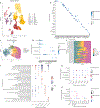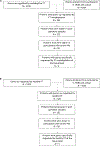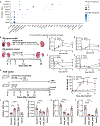Analysis of the human kidney transcriptome and plasma proteome identifies markers of proximal tubule maladaptation to injury
- PMID: 38091407
- PMCID: PMC11405121
- DOI: 10.1126/scitranslmed.ade7287
Analysis of the human kidney transcriptome and plasma proteome identifies markers of proximal tubule maladaptation to injury
Abstract
Acute kidney injury (AKI) is a major risk factor for long-term adverse outcomes, including chronic kidney disease. In mouse models of AKI, maladaptive repair of the injured proximal tubule (PT) prevents complete tissue recovery. However, evidence for PT maladaptation and its etiological relationship with complications of AKI is lacking in humans. We performed single-nucleus RNA sequencing of 120,985 nuclei in kidneys from 17 participants with AKI and seven healthy controls from the Kidney Precision Medicine Project. Maladaptive PT cells, which exhibited transcriptomic features of dedifferentiation and enrichment in pro-inflammatory and profibrotic pathways, were present in participants with AKI of diverse etiologies. To develop plasma markers of PT maladaptation, we analyzed the plasma proteome in two independent cohorts of patients undergoing cardiac surgery and a cohort of marathon runners, linked it to the transcriptomic signatures associated with maladaptive PT, and identified nine proteins whose genes were specifically up- or down-regulated by maladaptive PT. After cardiac surgery, both cohorts of patients had increased transforming growth factor-β2 (TGFB2), collagen type XXIII-α1 (COL23A1), and X-linked neuroligin 4 (NLGN4X) and had decreased plasminogen (PLG), ectonucleotide pyrophosphatase/phosphodiesterase 6 (ENPP6), and protein C (PROC). Similar changes were observed in marathon runners with exercise-associated kidney injury. Postoperative changes in these markers were associated with AKI progression in adults after cardiac surgery and post-AKI kidney atrophy in mouse models of ischemia-reperfusion injury and toxic injury. Our results demonstrate the feasibility of a multiomics approach to discovering noninvasive markers and associating PT maladaptation with adverse clinical outcomes.
Conflict of interest statement
Figures




References
MeSH terms
Substances
Grants and funding
- R01 HL085757/HL/NHLBI NIH HHS/United States
- U01 DK114866/DK/NIDDK NIH HHS/United States
- U01 DK133097/DK/NIDDK NIH HHS/United States
- U01 DK133090/DK/NIDDK NIH HHS/United States
- R01 DK093771/DK/NIDDK NIH HHS/United States
- U01 DK114933/DK/NIDDK NIH HHS/United States
- U01 DK114908/DK/NIDDK NIH HHS/United States
- U01 DK133095/DK/NIDDK NIH HHS/United States
- UH3 DK114866/DK/NIDDK NIH HHS/United States
- U01 DK133081/DK/NIDDK NIH HHS/United States
- U01 DK114907/DK/NIDDK NIH HHS/United States
- K01 DK120783/DK/NIDDK NIH HHS/United States
- U01 DK114920/DK/NIDDK NIH HHS/United States
- U24 DK114886/DK/NIDDK NIH HHS/United States
- U01 DK133766/DK/NIDDK NIH HHS/United States
- U01 DK114923/DK/NIDDK NIH HHS/United States
- U01 DK133113/DK/NIDDK NIH HHS/United States
- U01 DK133768/DK/NIDDK NIH HHS/United States
- UH3 DK114861/DK/NIDDK NIH HHS/United States
- U01 DK133092/DK/NIDDK NIH HHS/United States
- U01 DK133091/DK/NIDDK NIH HHS/United States
- U01 DK133093/DK/NIDDK NIH HHS/United States
LinkOut - more resources
Full Text Sources
Miscellaneous

